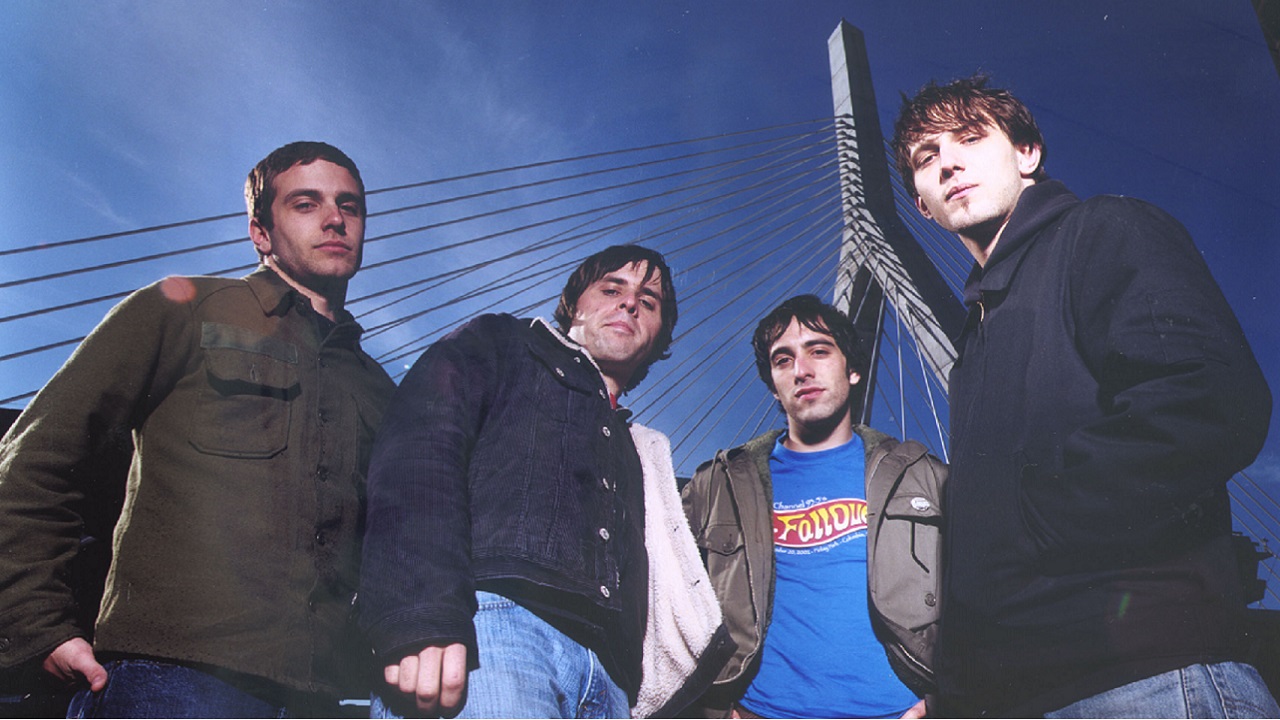The metal scene was itching for something fresh as the new millennium dawned. Ever since grunge had up-ended trad metal at the start of the 90s, the scene had been rapidly evolving in sound and aesthetic, but by 2000 even nu metal was looking decidedly dog-eared. Unsurprisingly, industry eyes (and ears) began to scour the underground, digging into the fertile grounds of post-hardcore, emo and metalcore to find the next big thing.
Bands like Glassjaw, AFI, and At The Drive In, who had spent much of the decade without troubling the eyes and ears of the mainstream were suddenly being courted by major labels, thrust onto magazine covers and getting heavy airplay on MTV. But while many found themselves struggling to adapt to their newfound interest and fame, none were more prepared than Cave In.
The Boston quartet had created a true underground metalcore classic with their 1999 debut, Until Your Heart Stops, then followed it up two years later with the groundbreaking Jupiter. Stripping away the molten fury of Until Your Heart Stops and replacing it with beautiful, shimmering progressive space rock, it confused the underground, but made a whole new section of music fans sit bolt upright.
It also caught the attention of the majors, who saw Cave In given the “emo-metal Radiohead” tag enough times to aggressively pursue them, the band ultimately signing to Sony subsidiary RCA Records.
“We saw it as an appealing opportunity to vastly expand Cave In’s audience and also possibly earn a humble living off our band without working nine-to-five-day jobs,” rhythm guitarist Adam McGrath tells Hammer. “At that time, none of us had anything we loved more or had worked harder for than Cave In. We were all ready to put our complete effort, time and energy into the band to take it as far as it would go.”
Spirits were high when Cave In set out for Cello Studios in Los Angeles to record their major label debut in 2002. But ever the punk rock band, they were also naturally distrustful of the company they now kept. “We of course wanted the record to do well, but we were well aware of the potential pitfalls of being in the major label world,” drummer and vocalist JR Conners says.
“It felt like the whole thing could be derailed at any moment. I remember us all trying to take the experience for what it was worth and focusing on making the record as best as we could.”
Easier said than done. Some members of the band were so acutely aware of the pressure of meeting label expectations that it actually began to take its toll on certain creative choices they were making as their new album, Antenna, took shape.
“Before writing Antenna, it seemed like there was always something in the way of our creative process: line-up changes, school, shit jobs, the band being spread out…” says vocalist and guitarist Steven Brodsky.
“Signing to a major label kicked it all into overdrive. I was equally thrilled and nervous about the opportunity to focus solely on writing a Cave In album. I was confident in our abilities as a group, but the scenario both challenged and messed with my self-confidence. I knew the band had potential to reach a new audience - I just couldn’t picture what it looked like. Consequently, some creative decisions were made that catered to an invisible mass of people, which sounds delusional, I know! Those are the moments when I was lost in the excitement of an unknown thing, for better or worse.”
Cave In may still have had a mindset of an underground punk band, but sonically Antenna was pulling from far more mainstream sounds. The influence of one huge, then-recent crossover success story lead to the creation of the album’s lead single, Anchor.
“The musical spirit of Anchor probably comes from being hyped on later-era Kyuss and early QOTSA,” Steven tells us. “The opening riff has the same downstroke eighth-note thing that happens in songs like Regular John and Avon from the first [QOTSA] album, which we loved.”
After a six-month period – a then unthinkable amount of time for a band who had recorded Jupiter in just four days – Antenna was complete. It was now time to show the record to their new paymasters, who were very receptive to one song in particular.
“Our A&R rep constantly said we needed a song like Soundgarden’s Black Hole Sun and he felt Anchor was that song,” says Adam. “He thought that Anchor would be the best way to introduce Cave In to a national radio audience, but I know we all felt there were better songs and singles on the record.”
Reservations aside, the band made their first ever video for the song. It was a simple but brilliant premise: a businessman wakes up to find his feet encased in concrete and we see his struggles as has to go about his day weighed down by the blocks.
“That was director Dean Karr’s idea and his interpretation of the song - I think it’s well done,” Steven smiles. “The fact that Dean got (actor and original Sonic Youth drummer) Richard Edson to play the lead role is huge. I remember arriving at the site where we did the band performance shot and feeling stunned by the production level; how much money was being spent, the number of people involved, having a make-up artist on site, that sort of thing. It was our first time making a music video, when just two years prior, we were recording Jupiter on a shoestring budget and surviving on Morning Star Chik Patties cooked in the studio microwave.”
Antenna was released on March 18, 2003, with Anchor following as a single two months later on May 19. Reviews for both the album and the song were glowing and it became the first Cave In album to chart in both the US and the UK, reaching No.169 in the former and 67 in the latter.
Anchor, with its driving riff, machine-gun drumming and gorgeous Beatles-esque harmony in the chorus, had everything to make it one the era’s definitive rock anthems. Unfortunately, it didn’t quite work out like that.
“When it dropped it barely had a lukewarm response,” Adam sighs. “There were certainly cries of ‘sell-out’ and people wondering how watered down we had become. I hoped we would have better luck with other singles down the line, but we really never made it that far. Excitement from the label dwindled after the first single dropped and our A&R rep left RCA shortly after Antenna’s release. All these events left Cave In rudderless in the major label machine.”
But there were high points, at least. In 2003, Cave In hit the road on the massive touring Lollapalooza that year, before opening for Muse and Foo Fighters, the European run with the Foos proving a particular highlight. “When I think back about those trips, what I remember most was how great the band and their crew treated us,” says JR. “It felt like we were part of the family, so to speak. We had great conversations and we learned a great deal watching their whole operation every night. Some of the best moments in the Antenna era came from those trips.”
After those tours, it became clear to both the band and the label that the relationship wasn’t a beneficial one for either party, and Cave In and RCA mutually cut ties. Cave In decided to revisit their more metal sound, 2005’s superbly brutal Perfect Pitch Black written as something of a backlash to the Antenna sound.
“The best thing to come out of [everything that happened] is Perfect Pitch Black,” Steven says defiantly. “In the wake of Antenna, I feel fortunate that we found the strength to stay together and make that statement. You’re not wrong in thinking it’s an angry record, but Cave In was an angry band from the start, and maybe we just came full circle.”
It’s a sentiment that the band seem to stand by all these years down the line. “I can’t say I have strong feelings positive or negative about Anchor,” Adam says. “I got to experience crazy adventures and travel the world by signing up to a major label. I think Anchor is a fine Cave In song for what it is.”
The experience may have burned the members of Cave In too much for Anchor to be one of their personal favourite songs, but it still stands as a breakout anthem from a band who had previously toiled as underground darlings. For those who knew nothing of post-hardcore from the Boston underground at the start of the millennium, Anchor was the perfect introduction.
It might not quite have been the crossover smash it certainly deserved to be, but to many it is a cult classic from a wildly different and brilliant time, representative of the shifting tides of heavy music as nu metal collapsed and entirely new and different scenes took its place.
Cave In play ArcTanGent Thursday August 17


